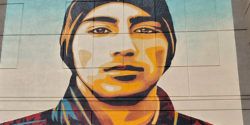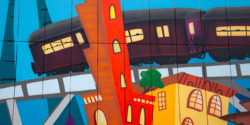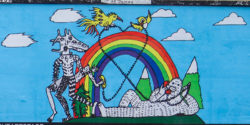“Dia de los Muertos”
Skulls are everywhere on the street today, and here is a collection to mark The Day of the Dead. The commemoration of people who have passed is observed nation-wide in Mexico every year at this time. Although it is not a national holiday, the strictly religious and cultural observance is revered and, depending on the region, it varies in the ways in which the holiday is marked.
The cultural aspect of this holiday has inspired many artists, filmmakers and poets. Here we have selected images of Street Art culled from our library to mark the Dia de Los Muertos, focusing on the most prominent symbol used to represent this holiday: “Las Calaveras” or skulls.
Mexico’s “Dia de los Muertos” or “Day of the Dead” takes place every year on November 2 to coincide with the catholic holiday of “El Dia de los Santos” or “All Saints Day”. The Day of the Dead is not the Mexican equivalent of Halloween. The Day of the Dead in Mexico is a celebration of Death and it does not carry any of the connotations of fear, fantasy and gore that Halloween does.
This religious and cultural holiday can be traced as long ago as 3000 years. Before the conquest of what’s now modern Mexico in the pre-Hispanic era the indigenous cultures celebrated death, rebirth and their ancestors by displaying human skulls as memento mori.
When the Spanish missionaries arrived more than 500 years ago they tried without success to eradicate such pagan and sacrilegious celebrations that seem to mock death while converting the indigenous people to Christianity. To the Spaniards death was the end of life but to the Aztecs it was a continuation of a journey not yet completed. The Aztecs embraced death and they celebrated it for the entire month of August, the ninth month of the Aztec Calendar, and the festivities were presided by the goddess Mictecacihuatl or “Lady of the Dead” presumed to have died at birth.
The Spaniards were met with fierce resistance in their attempts to vanish the rituals so in frustration they sought and found a common ground with the natives by moving the pagan rituals to coincide with the Catholic holiday of “El Dia de los Santos” or “All Saints Day” on November 2.
Modern Mexicans remember their friends and family members that have departed from life by honoring them with extravagant festivities that, depending in the region might include lavish offerings or “ofrendas” in private altars in the cemeteries at the tombs of their loved ones and/or at home. It is a day of celebration and many people elect to stay overnight at the cemetery for prayer, and remembrance but partying, eating and drinking is encouraged and expected always following the norms of respect and decorum for the defunct.
These “ofrendas” or gifts include the most favored dishes, foods and beverages that their loved ones enjoyed while alive. They also include photos and other personal mementos of the deceased ones. The “ofrendas” are meant to be eaten and shared by the relatives and friends of the departed and sometimes they are very elaborate five course dinners. Other times the relatives might choose to have a daytime picnic at the cemetery and return to their homes at dusk. The “ofrendas” are believed to nurture and help the souls of the dead while in their journey to heaven.
Some people use this day to just take their customary once a year trip to the cemetery to clean and maintain the tomb of their loved ones.
Regardless of the singular cultural distinction of each region two symbols are common throughout the country: “La Calavera” or The Sugar Skull and “La Catrina” or The Skeleton Lady. The Skulls can be made of sugar and chocolate and often are inscribed with the recipient’s names and are gifts to both the living and the dead. There is also “El Pan de Muertos” or “Bread of the Dead” which Mexicans give as gifts to the visiting relatives for their journey back home.
It is said that Mexicans not only celebrate death they also eat it.
Main Banner image credit: Jose Guadalupe Posada “Gran Calavera Eléctrica” Courtesy Library of Congress.
Other Articles You May Like from BSA:
In the footsteps of slavery This week Saype is painting the latest installment of his project “Beyond Walls” in Ouidah, Benin, and the location is tragic because of its history. SAYPE. "Beyond ...
AYÚDANOS A DEFENDER LA HUERTA Y PARAR LA ZAL - Help Us to Defend the Garden and Stop the ZAL. Street Artists in Valencia, Spain are using their work to reclaim land for a people's agenda. ...
It's the ultimate captive audience for your artwork. That wasn’t the original intention for this Swiss prison mural project called 4661m² but it is one of the outcomes - and one of its myriad ironies....
Leon Keers is subversive, if that is the way your mind works. His mind-bending plays on real and surreal perspectives may lead you down a path of suspicion, for it appears that he is adept and agile ...
Urban Nation’s Love Letters to the City, curated by Michelle Houston, is both an exhibition and a fulsome, sophisticated incantation. It invites audiences to confront the layered realities of urb...
 BROOKLYN STREET ART LOVES YOU MORE EVERY DAY
BROOKLYN STREET ART LOVES YOU MORE EVERY DAY









